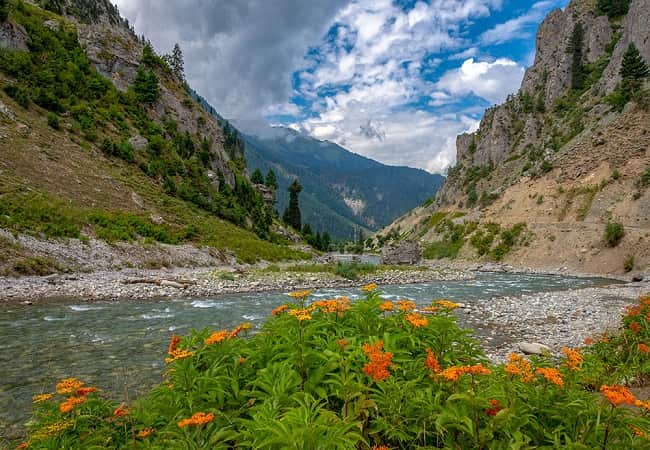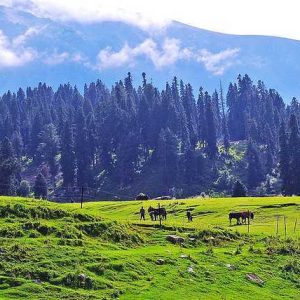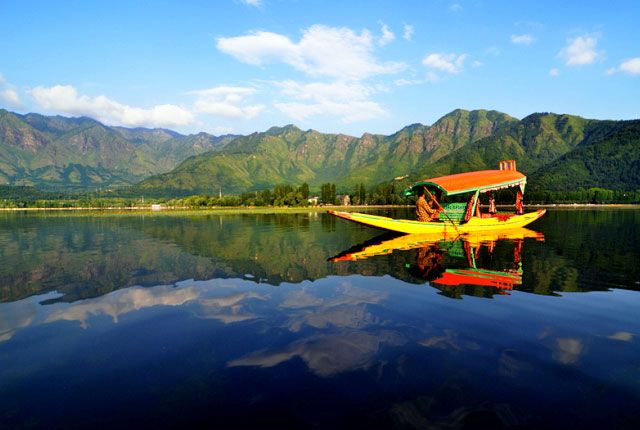
Best Time to Visit Gurez Valley
Table of Contents
ToggleOverview
Sitting in the arms of the great Himalayas, Gurez Valley is the perfect offbeat tourist destination for nature enthusiasts and adventure sports enthusiasts alike. Preparing for your visit, knowing when to come to Gurez Valley can really be the difference between a great holiday and a draining expedition. From snow-covered scenery to colorful alpine meadows, Gurez has something new to offer in every season. In this detailed Gurez travel guide, we’ll take you through the seasonal subtleties, climatic trends, local celebrations, practical travel advice, and all you need to know to make the most out of your trip.





Climate and Geography of Gurez Valley
Gurez Valley, situated at an elevation of approximately 2,400 meters above sea level, is distinguished by rugged ridges, meandering rivers, and dense forests. Gurez weather is highly affected by both western disturbances and monsoon patterns, with clear season differences:
- Winter (December to February): Below-zero temperatures, heavy snowfall, and sporadic road closure.
- Spring (March to May): Melting snow, blooming flora, and modest warmth.
- Summer (June to August): Warm weather, lush foliage, and blue skies.
- Autumn (September to November): Cool air, good visibility, and changing colours.
It is important to realize these climatic changes while choosing to visit Gurez Valley, particularly if you want to see snow-capped mountains or lush spring flowers.
Winter Wonderland: December to February
Why Winter?
If your heart’s desire is a Gurez snowfall wonder, winter is the time for you. The valley becomes a clean white sheet of snow, the Kishanganga River is frozen halfway, and mountains around glitter in icy glory.
Highlights
- Snow Trekking: Venture onto frozen routes with the help of expert local guides.
- Ice Fishing: Attempt drilling into the frozen river surface to catch trout.
- Winter Festivals: Get a taste of local cultural celebrations such as the Gurez Winter Festival with folk dances, bonfires, and local cuisines.
Challenges
- Harsh Cold: Day temperatures around 2–5°C drop to –10°C or more at night.
- Accessibility Issues: The Razdan Pass frequently gets closed, and road travel becomes difficult.
- Limited Facilities: Several guesthouses are shut for the season, so advance booking and confirmation of availability is required.
Spring Bloom: March to May
Why Spring?
Gurez Valley spring is a kaleidoscope of colors with wildflowers covering the grasslands and fruit trees flowering. This season is fast gaining popularity among nature-loving tourists and photographers in search of the best “Gurez travel guide” moments.
Highlights
- Wildflower Trails: Hike over hillsides blanketed with blue poppies, primulas, and rhododendrons.
- Birdwatching: See migratory birds such as Himalayan griffons and golden eagles along river banks.
- Local Handicrafts: Encounter artisans weaving delicate pashmina shawls and woodwork.
Weather Conditions
- Temperatures: Day temperatures range from 10–18°C; nights are cold at 2–6°C.
- Precipitation: Little rain, but light showers now and then keep the valley green.
- Spring hits the right balance between accessibility and natural scenery, emerging as a strong contender for best season to travel to Gurez Valley.
Summer Retreat: June to August
Why Summer?
Summer marks the height of tourist season in Gurez Valley. Clear skies and daytime temperatures of 15–22°C make this the ideal time to sightsee, trek, and explore rivers.
Highlights
- Gurez River Rafting: Ride thrilling rapids with expert rafting operators.
- Campsite Picnics: Pitch camps on riverbanks under walnut trees’ shade.
- Cultural Exchange: Visit tribal music shows and taste local cuisine such as Gurez trout curry.
Tourist Influx & Booking Tips
- Peak Season: Summer season is the peak time, thus the lodgings get full quickly.
- Advance Reservations: Book homestays or eco-resorts a minimum of 2–3 months before.
- Day Tours: Day-travelers can opt for guided tours from Bandipora to ensure smooth arrangements.
- Comparing Gurez Valley best time to visit vs. crowd, summer is the most convenient and activity-packed.
Monsoon & Post-Monsoon: September to November
Why Autumn?
After monsoons, the valley has crystal clear views and pleasant temperatures, ideal for a photographer’s haven. Golden autumn landscapes in travel blogs targeting Gurez tourism keywords are perfect.
Highlights
- Photography Tours: Panorama shots of Himalayas with less haze.
- Harvest Festivals: Join apple-picking festivals and enjoy fresh fruits.
- Stargazing Nights: Enjoy the world’s best night skies due to low humidity.
Considerations
- Occasional Showers: September’s late monsoon showers may result in small landslides.
- Shorter Days: As winter draws near, daylight hours decrease, so plan early mornings.
- Autumn bridges the gap between summer’s exuberance and winter’s loneliness and provides a peaceful setting to anyone looking for “Gurez autumn travel.”
Essential Travel Planning
How to Reach Gurez Valley
- By Air: Nearest airport is Srinagar International Airport (around 130 km).
- By Road: Drive along the scenic route through Bandipora via Razdan Pass (closed during November to April).
- By Rail: Nearest major railhead is Jammu Tawi Railway Station (around 330 km).
Travel Tip: If you’re exploring when to visit Gurez Valley, ensure the Razdan Pass is open for your travel dates. Winter travelers may need to reroute via Kupwara if the pass is blocked.
Accommodation Options
- Homestays: Immerse yourself in local life with Wakhi hosts offering traditional meals.
- Guesthouses: Budget-friendly and spread across Dawar town.
- Eco-Resorts: Limited but luxurious, ranging from tented camps to wood-cabin stays.
Pro-tip: To really experience Gurez travel guide style, choose homestays that also organize local guides.
Local Festivals and Cultural Highlights
- Gurez Winter Festival (February): Snowman-building contests, folk dancing, and hot Kashmiri tea.
- Urs of Sheikh ul Alam: Pilgrims at the shrines in Kashmir, with smaller numbers in Gurez.
- Harvest Festivals (September): Mark apple and walnut harvests with village feasts.
Integrating these events into your itinerary elevates your Gurez tourism experience, ensuring authentic interactions with local communities.
Adventure Activities and Treks
- Naranag to Gurez Trek: A challenging 3-4 day trek crossing mountain passes and alpine lakes.
- Alpather Lake Trek: Witness one of Kashmir’s highest lakes, nestled amidst snowfields.
- River Rafting & Kayaking: Best between June and August when river flows are optimal.
When it comes to trekking to Gurez, summer and early autumn are the best times, as they provide both accessibility and visual beauty.
Packing List & Preparation
- Clothing: Layered clothing, thermal insides, waterproof outerwear, and trekking shoes.
- Gear: Sunglasses, sunscreen (high SPF), trekking stick, daypack, and water bottle.
- Documents: Valid identification, permits (if required), emergency numbers, and copies of bookings.
Adjust this checklist to the Gurez weather forecast during your travel period to not pack too much or forget something vital.
Health, Safety, and Local Etiquette
- Altitude Sickness: Acclimatize slowly; stay hydrated and avoid physical exertion on Day 1.
- Wildlife Caution: Snow leopard and bear sightings are unlikely; hearken to local guide advice.
- Cultural Sensitivity: Dress conservatively—women, shoulders and knees covered; request permission before taking pictures of locals.
Your Gurez travel guide must include respect for community traditions to have a positive influence on wildlife and communities.
Culinary Delights of Gurez
- Gurez Trout: Catch of the day cooked simply with minimal spices to let its natural flavor shine through.
- Rogan Josh & Dum Aloo: Traditional Kashmiri dishes in homestays with tsot bread.
- Bakarkhani & Noon Chai: Comfort food after a cold day of adventure.
Food is the epicenter of tourism in Gurez, where each meal is a reflection of Kashmiri hospitality and culinary culture.
Photography and Social Media Guidelines
- Golden Hour Photos: Sunrise on the Razdan River provides magical light for landscape photography.
- Drone-Shot Areas: Verify local laws; most homestays permit drones for valley landscape shots.
- Hashtag Plan: Utilize “#GurezValley,” “#BestTimeToVisitGurez,” and “#GurezTravelGuide” to increase visibility.
Sustainable and Responsible Travel
- Plastic-Free Travel: Bring reusable bottles and bags; use no single-use plastics.
- Support Local Economy: Buy handicrafts and employ local guides so that tourism reaches communities.
- Leave No Trace: Properly dispose of trash and avoid disrupting wildlife habitats.
A good Gurez travel guide stresses going out of the valley as untouched as you came in.
Conclusion: Choosing Your Ideal Time
- For Snow Lovers: December to February, when Gurez snowfall makes the valley a winter wonderland.
- For Wildflower Enthusiasts: March to May, best for spring flowers and pleasant Gurez weather.
- For Outdoor Activities: June to August, with best river rafting, trekking, and foliage.
- For Photographers: September to November, with clear skies and autumnal hues.
Ultimately, the best time to visit Gurez Valley depends on your interests—be it snow trekking, floral meadows, or cultural immersion. With this comprehensive Gurez travel guide, you’re now equipped to plan an unforgettable journey to one of the Himalayas’ most enchanting valleys. Pack your bags, mark your calendar, and get ready to discover Gurez!
Conclusion: Reasons Why Drass Should Appear in Your Bucket List
Drass is a tourist site for every travel aficionado. If you appreciate history, yearn for adventure, or just love nature, this captivating region with its raw natural beauty and rich history will certainly impress you. The presence of war memorials, beautiful valleys, high altitude treks, and cold desert landscapes are unique to Drass, making it a spectacular destination for offbeat travelers.
When planning a visit to Ladakh, Drass needs to be on your list for exploration. This site is like no other in the world with its incredible blend of nature, adventure, and history. So, grab your bags and get ready to delve into one of the most thrilling and overlooked places in India.
How to book Kashmir tour?
Contact a travel agency that specializes in Kashmir tours. You can reach out to the following for assistance:
- Phone:
- +91 7889 655596
- +91 7006 891267
- Email:
Inquire about tour packages, itineraries, and pricing, and confirm your booking for a memorable winter experience!
People Also Ask
What is the best time to visit Gurez Valley for snow activities?
The optimal period for snow activities in Gurez Valley is from December to February, when the valley is blanketed in fresh snow and temperatures range from –10°C to 5°C, making it perfect for snow trekking, ice fishing, and winter festivals.
When does Gurez Valley experience its spring bloom?
Spring blooms in Gurez Valley from mid-March through May, with daytime temperatures of 10–18°C. This is when wildflowers such as blue poppies and rhododendrons carpet the meadows, offering ideal trekking and photography opportunities.
Which months offer the best weather for river rafting on the Kishanganga?
The prime months for river rafting and kayaking on the Kishanganga River are June through August, when water flow is robust and daytime temperatures hover between 15°C and 22°C.
Is autumn a good time to visit Gurez Valley for photography?
Yes, September to November provides crystal-clear skies, golden foliage, and minimal haze—perfect for capturing Himalayan vistas and valley panoramas at sunrise and sunset.
How do I reach Gurez Valley from Srinagar?
You can drive approximately 130 km from Srinagar International Airport via the Bandipora–Razdan Pass route. Note that Razdan Pass may close in winter, requiring alternate routes via Kupwara.
Are homestays available year-round in Gurez Valley?
Most homestays operate from March through November. In peak summer (June–August) and spring, availability is high, but many close during heavy snowfall in deep winter.
Do I need special permits to visit Gurez Valley?
No special permits are typically required for domestic tourists, though it’s wise to carry valid ID and check local guidelines if you plan to trek into restricted areas near the Line of Control.
What should I pack for a trip to Gurez Valley?
Essentials include layered clothing, thermal wear for winter, waterproof jackets, sturdy trekking boots, sunscreen, sunglasses, a daypack, and reusable water bottles—tailored to the Gurez weather forecast.
Can I witness trout fishing in Gurez Valley?
Yes—especially from March to August—when the Kishanganga River hosts abundant trout. Ice fishing is popular in deep winter, while open-water fishing runs through spring and summer.
Which local festivals should I plan my Gurez Valley trip around?
Consider the Gurez Winter Festival in February for cultural performances, and local harvest celebrations in September and October, featuring apple-picking and village feasts.
Is trekking in Gurez Valley safe during monsoon months?
While heavy monsoon rains are rare, September can bring occasional showers and minor landslides. Early autumn trekking remains generally safe with clear trails and cooler temperatures.
Are there guided tour options for first-time visitors?
Yes—several local operators offer guided day tours from Bandipora, multi-day treks like the Naranag–Gurez route, and river rafting packages, ensuring safe and organized travel.
What altitude-related health precautions should I take?
Gurez Valley sits around 2,400 m above sea level. Acclimatize gradually, stay hydrated, avoid strenuous hikes on day one, and carry altitude sickness medication if prone to sensitivity.
Which is the most budget-friendly time to visit Gurez Valley?
Shoulder seasons—March to May and September to November—offer moderate rates on homestays and guesthouses, with fewer crowds and lower prices than peak summer months.
Can I book eco-resorts in Gurez Valley in advance?
Yes, eco-friendly resorts and tented camps are limited in number. Booking 2–3 months ahead of your travel dates (especially for June–August) is recommended to secure a spot.
Is Gurez Valley suitable for solo travelers?
Absolutely—solo adventurers can join group treks or stay in homestays, but should inform hosts of their itinerary and travel with reputable local guides, particularly in winter.
What wildlife might I encounter in Gurez Valley?
While rare, you may spot Himalayan marmots, ibex, and various birds of prey. Always follow guide instructions and maintain a respectful distance from wildlife.
How reliable is mobile connectivity in Gurez Valley?
Mobile networks (primarily BSNL) can be intermittent, especially in higher reaches. Download offline maps and carry a portable power bank for emergencies.
Can I use drones for aerial photography in Gurez Valley?
Many homestays permit drones, but you should verify local regulations and avoid flying near sensitive border areas. Early morning and late afternoon provide the best lighting.
What are the top day hikes around Gurez Valley?
Popular hikes include the short trail to Razdan Pass viewpoint, the alpine meadow trek near Dawar, and the scenic walk along the Kishanganga River banks.
Are there medical facilities available in the valley?
Basic clinics in Dawar and Neel villages handle minor ailments. For advanced care, travelers may need to visit Bandipora or Srinagar; carry a well-stocked first-aid kit.
How eco-friendly is tourism in Gurez Valley?
Many operators emphasize sustainable travel—plastic-free initiatives, solar-powered accommodations, and local-community-led homestays ensure minimal environmental impact.
What unique souvenirs can I buy in Gurez Valley?
Look for handwoven pashmina shawls, traditional walnut wood carvings, and local honey. Purchasing directly from artisans supports the valley’s economy.
Which months are best for birdwatching in Gurez Valley?
Spring (April–May) and autumn (September–October) attract migratory birds like Himalayan griffons, golden eagles, and various warblers along riverbanks and forest edges.
How can I ensure a responsible visit to Gurez Valley?
Follow “leave no trace” principles, use reusable containers, shop local, hire certified guides, respect cultural norms, and avoid disturbing wildlife habitats to preserve the valley’s pristine beauty.




